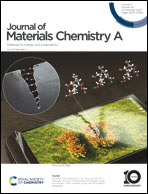Triallyl isocyanurate enabled SPAN-based organosulfur featuring high sulfur & selenium loading for advanced Li/Na–S batteries†
Abstract
Sulfurized polyacrylonitrile (SPAN), featuring uniform dispersion of short-chain sulfur in an organic skeleton, shows great promise in lithium–sulfur (Li–S) batteries due to the inhibited polysulfide dissolution and hence improved electrochemical performance. However, the practical applicability of SPAN is significantly limited by its relatively poor ionic and electronic conductivity, as well as sulfur content (<50%). Herein, triallyl isocyanurate (TI) is incorporated to fabricate SPAN fibers with robust chemical structure and high sulfur loading. The fine-tuned organosulfur cathode (Se0.05S0.95PAN-TI11, 1F) demonstrates increased S&Se content of 54.2% and excellent electrochemical performance in Li/Na–S batteries. As a result, 1F exhibits an ultrahigh composite capacity of 671 mA h g−1 at 0.1C (capacity retention up to 100%) and remarkable rate capability of 405 mA h g−1 at 8C in Li–S batteries. Additionally, 1F shows prolonged cycling ability over 300 cycles at 0.5C when applied in an RT-S battery. Notably, under harsh conditions (S&Se loading of 5.5 mg cm−2 and E/S&Se = 5 μL mg−1), the Li–1F battery displays a brilliant initial areal capacity of 8.0 mA h cm−2 at 0.1C (reversible capacity of 6.3 mA h cm−2) and retains a capacity of 5.3 mA h cm−2 at the 200th cycle (capacity retention of 84%). Consequently, 1F is promising for practical applications in high-performance metal–S batteries.



 Please wait while we load your content...
Please wait while we load your content...